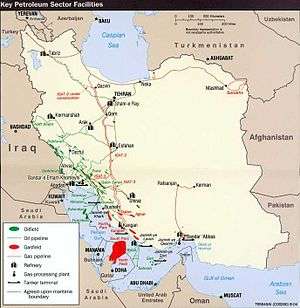Persian Pipeline
| Persian Pipeline | |
|---|---|
| Location | |
| Country | Iran, Turkey, Greece, Italy, Switzerland, Austria, Germany, France, Spain |
| General direction | south-west-north |
| From | Assaluyeh |
| Passes through | Bazargan |
| To | Europe |
| General information | |
| Type | natural gas |
| Partners | National Iranian Gas Export Company (NIGEC) |
| Operator | currently based on Build-Own-Operate |
| Expected | 2014 |
| Technical information | |
| Length | 3,300 km (2,100 mi) |
| Maximum discharge | 37–40 billion cubic meters per year |
Persian Pipeline, also known as the Pars Pipeline and Iran–Europe pipeline, (Persian: خط لولهٔ پارس) is a proposed natural gas pipeline to transfer Iranian gas from the Persian Gulf to European markets.[1]
Route
This planned pipeline will connect Iran's South Pars gas field with Turkey and then with European markets. It would consist of two principal sections:
- Iranian section, also is called Iran Gas Trunkline 9 or IGAT-9, starting in Assaluyeh will transport gas from South Pars gas field to the city of Bazargan at the border with Turkey.[2][3]
- The European section, which will cross Turkey, passing on to Greece and Italy.[2][3] In Italy the pipeline would be split:the northern branch will run to Switzerland, Austria and Germany, while southern branch will supply France and Spain.[4][5][6] It is not clear if the Trans-Adriatic Pipeline, foreseen for Iran gas export to Europe, would be part of this project or not.
Technical description
The overall length of the pipeline would be 3,300 kilometres (2,100 mi) and the capacity would be 37–40 billion cubic meters of natural gas per year.[4][7][8] The cost of Iranian section is estimated to be around $7 billion. This section will be 1,800 kilometres (1,100 mi) long and it would consist of 17 compressor stations. Each compressor station would have 4 turbo compressors. The cost of each station is expected to be around $100 million.[2]
The Turkish section will be 660 kilometres (410 mi) long and cost about one billion euro.[8] The pipeline would cross the difficult geographic environments, notably mountainous areas. It is expected to be operational by 2014.[2][8][9]
Ownership
The pipeline is proposed as a Build-Own-Operate project. According to the National Iranian Gas Export Company (NIGEC) two Iranian and two foreign companies were bidding for the contract awarded to one Iranian company or consortium and one foreign company.[2] It is possible that Iran and Turkey will set up a joint company for the building of a pipeline in Iran to the Turkish border, and another joint company on the construction of a gas pipeline in Turkey from Iran's border to the Greek border.[10] It is also alleged that Iran is relying on financial involvement from China. China is reportedly to consider $42.8 billion for investment in Iranian refineries and pipelines.[11]
Iranian Oil Minister Masoud Mir Kazemi confirmed in July 2010 that NIGEC and Turkey's Som Petrol signed a contract to build a pipeline that will cross Turkey.[8]
Alternative projects
The Persian pipeline is seen as an alternative to the Nabucco pipeline.[7] Although Iran was willing to be a part of the Nabucco project, the Iranian government reconsidered its options and decided to focus on the Persian pipeline. According to Hossein Zoulanvar, a member of Majlis Energy Commission of Iran, the reasoning to construct and use Persian pipeline for exports to Europe instead comes from US pressures on European countries to impose sanctions on Iranian gas sector. It is noteworthy that Russia which had been trying to block Nabucco project from realization has been trying to re-route Azerbaijani gas exports planned for initial phase of the project through other possible pipelines such as Mozdok – Makhachkala – Kazi Magomed pipeline. Although many argue that Persian pipeline may seem as an alternative to Nabucco, hence rival to South Stream project, Russia denounces the allegations and backs the Iranian initiative of building Persian pipeline.[12]
References
- ↑ "Iran starts Persian gas pipeline construction". PressTV. 30 May 2009. Retrieved 2009-05-30.
- 1 2 3 4 5 "Iran Seeks Foreign Investment for $8B Gas Pipeline". Fars News Agency. Payvand News. 2008-09-30. Retrieved 2009-02-22.
- 1 2 "Iran Plans to Build Pipelines to Export Gas to Europe". Fars News Agency. 2008-07-20. Retrieved 2009-02-22.
- 1 2 "Iran eyes $4bn gas pipeline to Europe". Upstream Online. NHST Media Group. 2008-09-24. Retrieved 2009-02-22.
- ↑ Ladane Nasseri; Lucian Kim (2008-09-24). "Iran Seeks to Build $4 Billion Gas Pipeline to Europe". Bloomberg. Retrieved 2009-02-22.
- ↑ Masoud Safa (2008-09-24). "Energy Silk Road Envisioned". Iran Daily. Archived from the original on 12 September 2008. Retrieved 2009-09-08.
- 1 2 S.Aliyev (2008-12-06). "Iran Presses Europe with Gas". Trend News Agency. Retrieved 2009-02-22.
- 1 2 3 4 "Iran reports Turkey gas deal, Ankara stands back". Reuters. 2010-07-23. Retrieved 2010-07-23.
- ↑ "Iran pipeline to supply gas to Europe". Tehran Times. 2008-10-30. Retrieved 2009-02-22.
- ↑ "Iran and Turkey firm up pipe plans". Upstream Online. NHST Media Group. 2008-12-17. Retrieved 2009-02-22.
- ↑ "Standing Up Against Nabucco". Hydrocarbons-technology.com. 2009-07-14. Retrieved 2009-11-17.
- ↑ "Russia Backing Persian Pipeline" (PDF). Iran Daily. 2008-12-07. Retrieved 2009-11-17.
